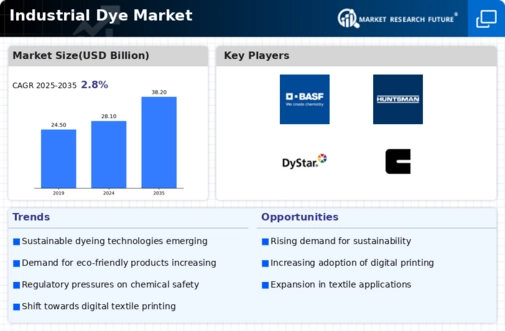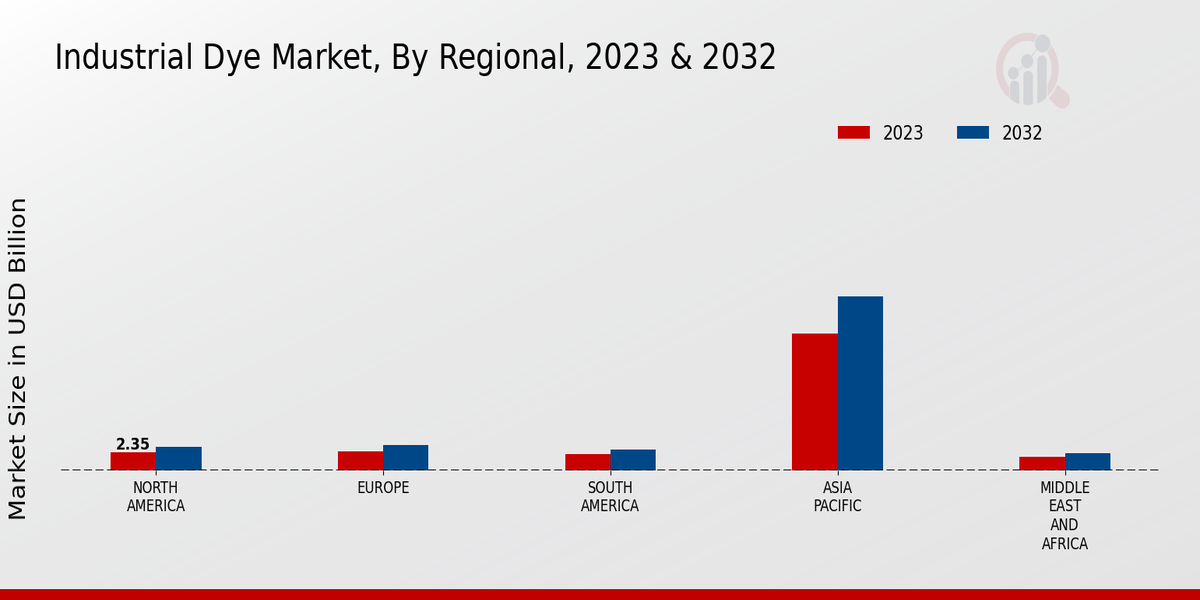Emerging Markets
Emerging markets are becoming increasingly influential in the Global Industrial Dye Market Industry. Countries in Asia-Pacific, Latin America, and Africa are experiencing rapid industrialization and urbanization, leading to heightened demand for dyes in various applications, including textiles, plastics, and coatings. This trend is particularly pronounced in regions where manufacturing capabilities are expanding, creating new opportunities for dye producers. As these markets develop, they are likely to contribute substantially to the industry's growth, with projections indicating a market value of 28.1 USD Billion in 2024, reflecting the potential of these regions.
Regulatory Compliance
Regulatory compliance is a critical driver in the Global Industrial Dye Market Industry. Governments worldwide are implementing stringent regulations regarding the use of hazardous chemicals in dyes, prompting manufacturers to reformulate their products. Compliance not only ensures safety but also enhances brand reputation, as consumers become increasingly aware of the environmental and health impacts of dyes. Companies that proactively adapt to these regulations may find new opportunities in the market, as they can offer safer, compliant products. This regulatory landscape is expected to shape the industry significantly in the coming years.
Sustainable Practices
The Global Industrial Dye Market Industry is increasingly influenced by the shift towards sustainable practices. As environmental regulations tighten, manufacturers are compelled to adopt eco-friendly dyeing processes and materials. This trend is evident in the rise of natural dyes and waterless dyeing technologies, which not only reduce environmental impact but also appeal to consumers seeking sustainable products. Companies that integrate these practices may gain a competitive edge, as sustainability becomes a key purchasing criterion. The market's projected value of 28.1 USD Billion in 2024 underscores the financial viability of these sustainable innovations.
Growing Textile Industry
The Global Industrial Dye Market Industry is significantly driven by the expansion of the textile industry. As global demand for textiles continues to rise, particularly in emerging markets, the need for high-quality dyes becomes paramount. This growth is supported by the increasing popularity of fashion and home textiles, which require a diverse range of colors and finishes. The textile sector's robust performance contributes to the overall market value, with projections indicating a compound annual growth rate of 2.82% from 2025 to 2035. This trend highlights the interdependence between the textile and dye industries.
Market Growth Projections
The Global Industrial Dye Market Industry is poised for growth, with projections indicating a market value of 28.1 USD Billion in 2024 and an expected increase to 38.2 USD Billion by 2035. This growth trajectory suggests a compound annual growth rate of 2.82% from 2025 to 2035. Such figures reflect the industry's resilience and adaptability in the face of evolving consumer preferences and regulatory landscapes. The anticipated expansion highlights the potential for innovation and investment within the sector, as stakeholders seek to capitalize on emerging opportunities.
Technological Advancements
Technological advancements play a pivotal role in shaping the Global Industrial Dye Market Industry. Innovations in dyeing technology, such as digital printing and automated dye application, enhance efficiency and reduce waste. These advancements allow for more precise color matching and faster production times, which are crucial in industries like textiles and plastics. As companies adopt these technologies, they can respond more swiftly to market demands, potentially increasing their market share. The anticipated growth to 38.2 USD Billion by 2035 reflects the positive impact of these technological developments on the industry.
















Leave a Comment